Table of Contents
Everybody struggles with retention.
For nonprofits, it is retaining donors (The year-to-date retention rate for donors in Q3 of 2023 stood at 30.7%!) For political organizations, it is consolidating support from their voters. And, of course, for businesses, it is getting their customers to buy again (they lose 15% of their customers every year).
When you look closer at all these segments, something really interesting pops up.
The reason why they leave is quite similar (check out the red highlights in the image).
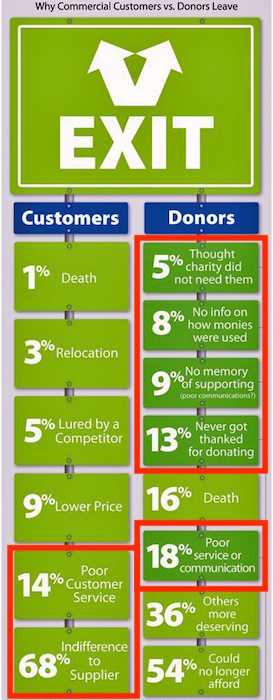
82% of customers and 53% of donors could’ve been retained had the organizations had better communication!
Now, I know what you are thinking.
“We send them emails and call them all the time. This does not pertain to us”.
Well, I would ask you to reconsider.
Because ‘better communication’ does not mean more calls or emails. It means targeted and pertinent communication at the right time!
For nonprofits, that could mean knowing how to make a fundraising ask and via what channel – without annoying the donor!
Businesses could send an email to customers who have not returned their periodic purchases to win them back.
For advocacy organizations, it could mean reaching out to a specific list of supporters who are more likely to turn up for an event.
And hey, such targeted communication is quite easy to do – with the right list segmentation. In this chapter, we will see how you can segment and target your audience to get more from them.
What is list segmentation?
List segmentation is the process of breaking down your audience into smaller chunks based on a common pattern. This allows you to better focus your efforts on segments that will give you higher returns and send your audience targeted information. According to a study by Mailchimp, segmented email campaigns can result in a 14.31% higher open rate compared to non-segmented campaigns.
E.g. A nonprofit can segment it’s donors into two fundamental categories – major donor or a small donor, based on how much they donate. For the next fundraising drive, depending on how much amount needs to be raised, you can target the segment that is more likely to donate.
Why is list segmentation important?
So Jane prefers to read on the phone, and John gives more during the holidays. Can such data really help your organization?
Absolutely!
The information you collect can give you a better idea of who your customers are and thus help you better cater to their requirements. A study by Experian found that personalized email campaigns generated transaction rates six times higher than non-personalized campaigns.
1. Better conversion
One of the secrets to high conversions, is leading up to the ‘big’ question (like a donation request or a product purchase), with a series of small asks.
The objective is to get a ‘yes’ for each of these small asks so the prospect gets into the habit of saying ‘yes’. This makes them much more likely to say ‘yes’ to the final ‘big’ question too.
Now, the tricky part is to get a consistent ‘yes’ from the prospect. That means asking the right questions and offering the right incentive to say ‘yes’.
List segmentation will give you enough insights to help you there. It will help you understand your prospects better, so that you lead up to your big ask with the right questions. Research by Campaign Monitor indicates that marketers have noted a 760% increase in revenue from segmented campaigns.
Here is an example of how a conversation can go:
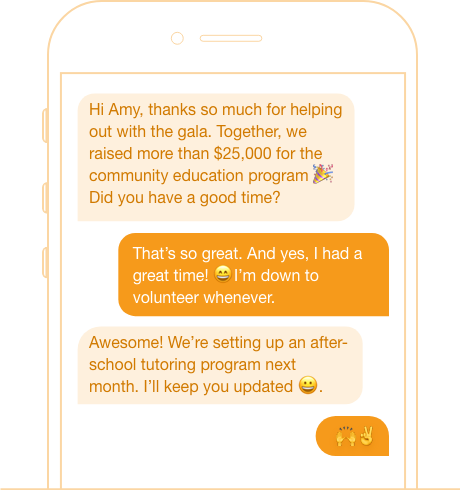
Notice that the above conversation is framed more like a volunteer update/appreciation. However, it is followed by another volunteering request for the next month!
List segmentation would tell you which supporters to contact based on their geographic location and past behavior (whether they have previously engaged with your organization).
In the above example, the text conversation would have been sent to only highly engaged and interested volunteers (and not to every contact on the list).
Thus, for nonprofits it will help bring more people to events, raise more funds etc. For businesses, it will mean more conversions!
2. More efficient use of resources (better strategy)
Since you have a clear idea of what it will take to get a ‘yes’ from the prospect, you would spend considerably fewer resources on nurturing.
That is, a volunteer or an agent will spend less time contacting the same prospects, won’t have to call multiple times, and will know exactly when to reach out for a sale or a donation.
Here is an example of how Amazon uses list segmentation to better understand its audience.
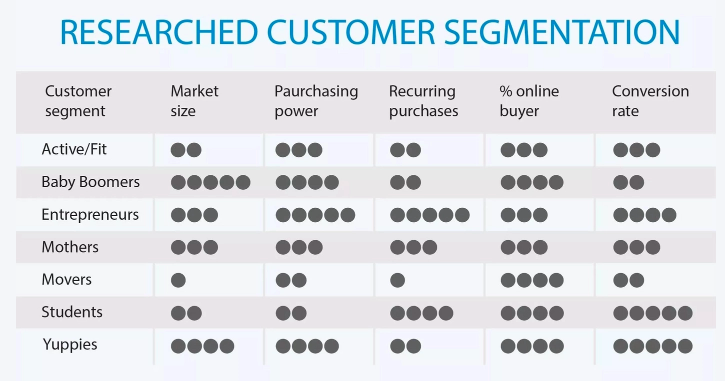
Based on this table, Amazon knows exactly which customer to reach out to for immediate growth. They will target the segment with a high conversion rate and reasonably big market size.
However, since this segment doesn’t tend to repeat purchases, it will also focus on ‘Entrepreneurs’—probably as part of their long-term growth strategy.
3. Understanding your audience better (more opportunities)
List segmentation helps you understand your audience better (with hard research) and gives you insights you would otherwise miss.
Let me give you another example here. BBC has well-researched consumer segments (of six) that classify their audience based on behavior that influences what content they consume.
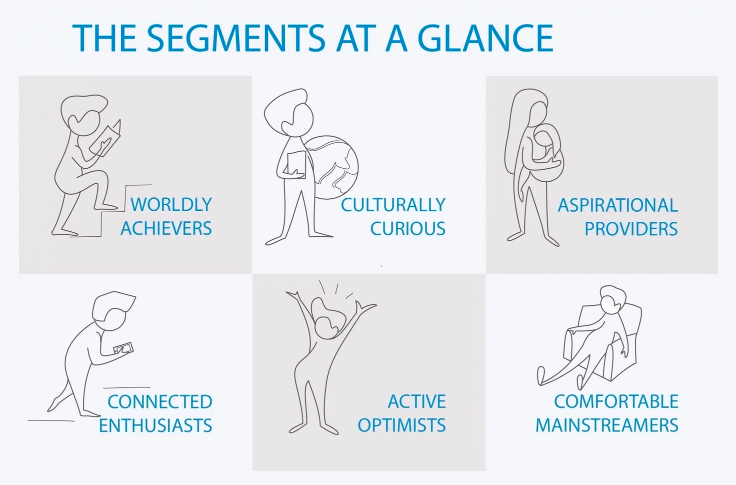
They found that the ‘Worldly Achievers’ and the ‘Culturally Curious’ have a higher chance of reading their content than others, so they decided to focus their efforts on them.
But hey, if you think this was ‘intuitive’, let me tell you a surprising number. The ‘Culturally Curious’ formed only 11% of the total population.
Intuition will tell you that focusing on a small number over others (say, the ‘Comfortable Mainstreamers’ = 18%) would be a mistake.
However, because this list segmentation takes into account behavioral data that ultimately ties to the readership, they were able to uncover a hidden segment within their audience whom they could nurture better!
What are the 4 major segmentation categories?
Please remember that Amazon and BBC’s list segmentation, outlined above, is unique to their organizations.
That is, they may not necessarily work for you.
However, to get started, here are a few fundamental ways (called the ‘classical list segmentation’) that can put you on the right path.
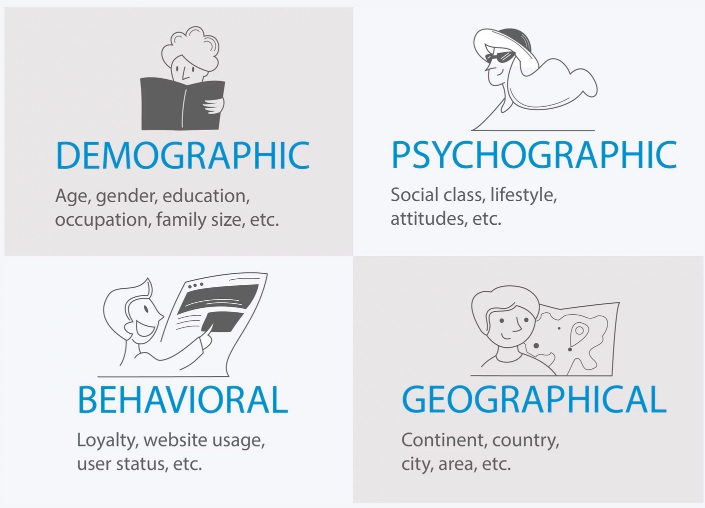
Analyze your existing donors and classify them according to the parameters above.
When you split the donor/supporter group based on age, you can broadly do it based on generation. That is, look at your audience to see if they are Millennials, Boomers, or Gen Zs.
Giving behavior is definitely influenced by generation – for instance, millennials tend to give more time than money. While for boomers, it is the other way around.
Family size and education also impact giving behavior. Studies have found that single women are more likely to contribute to charity, and in higher amounts, than similarly situated men.
Middle class families have higher chances of being monthly recurring donors, than families that are better off. They are also likely to give more in the long run – when compared to those who give only once.
Behavioral list segmentation will look at the giving and engagement patterns of the donors with your nonprofit. Here are a few parameters that can be considered:
- How often do your donors give?
- What is the average giving size?
- Do they prefer mobile/online giving?
- What segment of donors give using cheques?
- Do they prefer to engage with you via mobile?
Marketing strategies for each of these segments differ drastically. Once you have clearly identified the characteristics of each of your audiences, you will be able to segment them better.
Your target audience will always be a combination of all the above four parameters.
If a nonprofit is struggling to meet its fundraising goal, it can develop a new channel targeting a specific audience segment.
That is, it can show targeted social media ads to those
- Who is loyal to the website (Behavioral),
- Who has the most potential to give (Psychographic),
- Who are most likely to use social media (Demographic).
If the cause is more pertinent to those in a specific area (Geography), then that parameter figures in too!
Apart from the above parameters, you can also segment the audience based on:
- Revenue: (or for nonprofits, donations). You can also classify your audience based on how much they spend on your organization.
- Channel: though this partly comes under ‘Behavioral’, identifying which channel your prospects tend to use the most can help inform your marketing strategy.
- Intent: Knowing why they interact with your organization. For nonprofits, it could mean knowing why a donor is giving. For businesses, it could be knowing the problem the prospect wants a solution for.
- Prospect journey: If you already have a defined prospect journey, then you can also classify the lead based on which stage he is in. Eg. If he is still in the ‘awareness’ stage, then you won’t call him with an Ask. Rather, you would send targeted Ads his way so that he moves down the funnel.
Lead list segmentation begins with list building
When Obama tweeted that he would announce his vice presidential candidate via text message, he generated 3 million signups for his campaign.
Way back in 2008, this was every campaign manager’s and marketer’s dream – millions of prospects to engage, raise funds, and consolidate support!
Fast forward to 2024, and marketers would be a bit divided in their enthusiasm. Let me tell you why.
Here’s how the campaigns were set up. The first is when a voter texts in with the keyword VP (2008)
The next is when a voter texts in with the keyword MIKE (2020)
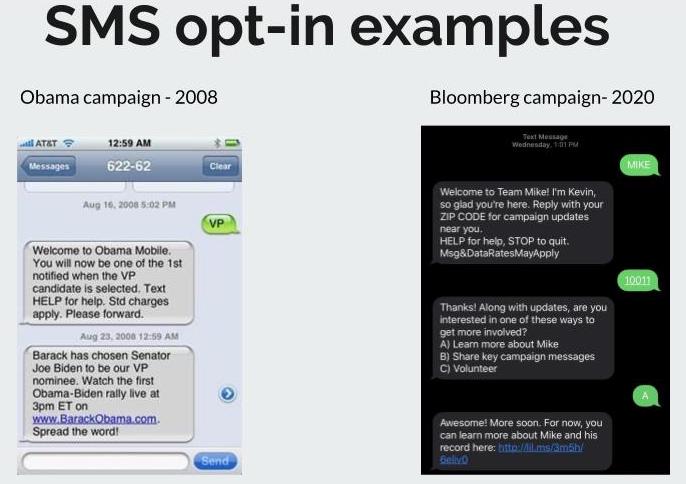
Essentially, all that the Obama campaign does is collect a phone number.
So, while they had 3 million contacts (yay), they also had 3 million contacts about whom they knew nothing!
Now, that is a huge problem, as they cannot segment the voters in this campaign without more information.
For instance, if they wanted to run a get out vote campaign for only the democrats, how will they know whom to send it to?
The list could include a lot of Republicans who had signed up because they were curious about the announcement!
On the otherhand, Bloomberg’s campaign in 2020 not only asked for a pincode (for geographic list segmentation), it also asked prospects if they would like to contribute more to the campaign!
That way, they could send volunteering requests to only those voters who send C. For the voters who choose A, they would send specific information about the candidate and so on.
The takeaway from this example is that – while list segmentation is important for nurturing your contacts, the foundation for setting it up happens during lead generation!
Here are a few lead generation channels that can help you collect the information you need.
Lead generation channels for list segmentation
A prospect/ lead engages with you across various channels during his journey. According to a study conducted by Statista, 73% of consumers engage with brands across multiple channels during their purchasing journey. Any of these channels can be successfully used to collect information!
1. Chat-bots for data collection
You can either use Facebook Messenger chatbots to engage your social media followers or custom-build your own chatbot for your website.
Since the bots are conversational, there are two things to keep in mind:
- The information you ask for should be in line with the conversation you have with your prospect.
- It should also depend upon the lead’s behavior. That is, first time visitors to the site are not asked directly for donation, but are shown interesting content about the impact your organization has had.
Here’s an example of how Drift does it on their website:
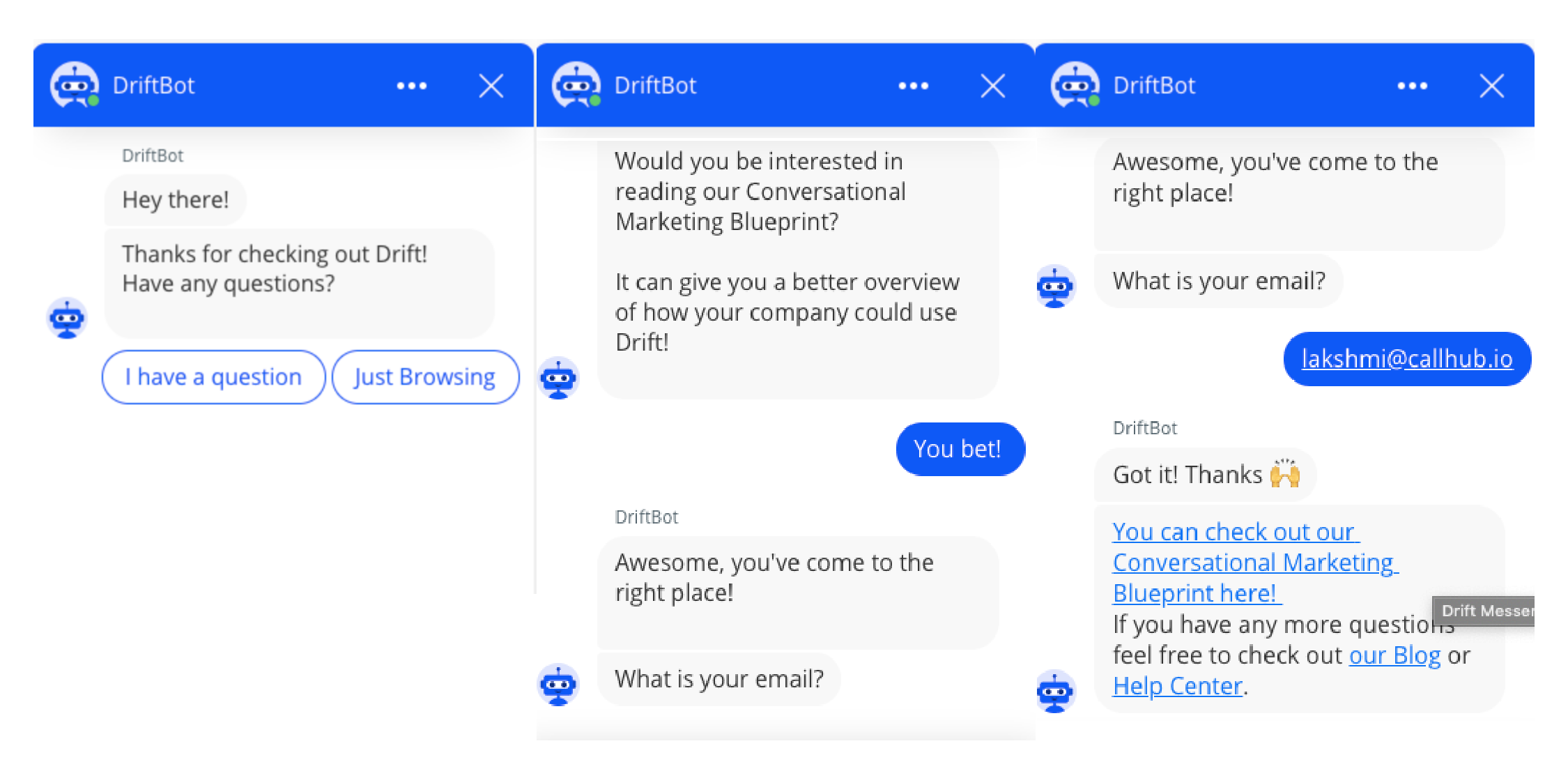
In this example since I was a first time visitor, Drift first asked me if I wanted to explore a bit more. Once I said yes, it requested my email ID.
Asking for my email was a reasonable demand here – as it was in exchange for good content. If they had asked me what organization I belonged to or the size of the company, I would not have shared the information.
For your nonprofit, the information you ask will be a bit different.
The email ID, the cause they care about, why they want to support your cause, etc., will be more important. The good news is that all of this information can be asked within a conversation.
However, requests to volunteer, making a donation, or attending an event are all high-barrier ask that cannot be pitched to new visitors. They can still be asked via a conversation, but a chatbot may not be the best channel for it.
2. Website forms for data collection
Your online donation forms are excellent channels for collecting more information about your prospect. The trick is in knowing where to make the ask and how.
The donation form itself should be easy to fill out. There should be nothing more complicated than entering a name and donation amount.
Once the donation is complete, you can direct them to the acknowledgment page, which collects more information.
You can have a checkbox asking the donor why they made the donation. Or ask them how they heard about you.
You can also ask if they would like to receive further information (or be kept in the loop) about your nonprofit’s major activities via text. This is an excellent way to get your donor’s phone number and consent to reach then via texts.
Keep in mind that your donors have just made a donation. That is a big ask. So now is no time to pepper them with another ask (like a volunteering effort or an event invitation).
Smaller asks like for a phone number (or consent) will work better.
You can also progressively collect information on the lead every time they visit your website (example below).

If your organization absolutely needs to obtain a lot of information upfront, consider splitting the form into stages (with a progress bar) to make it easier for your lead to complete.
3. Email for data collection
Emails come in handy for data collection because the responses can be synced with your CRM and be later used to inform your communication
Here’s how we did it at CallHub, sometime back:
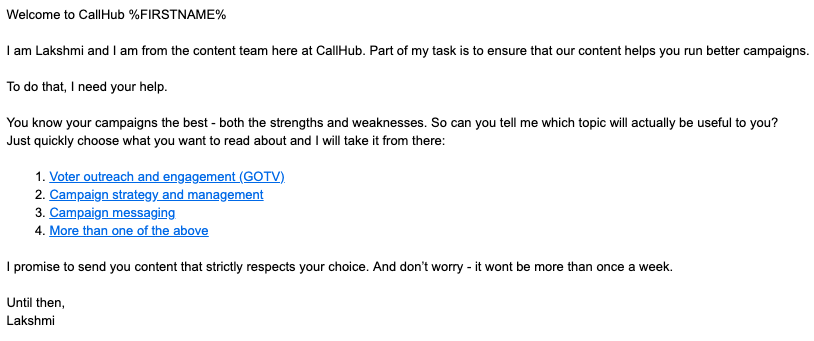
This email goes out to those leads who have subscribed to our newsletter. Depending upon their content preference, they can choose any of the links in the email.
The responses get recorded in our CRM so we send them future communication according to their preference.
The idea here is not ensure that the barest minimum of information is requested in forms, and all follow-up information is requested via email.
This way, the forms are easy to fill out, and you can still get information to better nurture your prospects.
For your organization, the kind of question to ask via email would be different.
Questions like “Why do they support your cause” or feedback surveys are excellent information that can be collected here.
Emails also work well to gather progressive information. E.g. even if a prospect has not donated, but requested your newsletters, you can ask if they would like to be further involved with your organization.
If they say yes, then the data can be sent to your CRM. You can then filter the positive responses and approach these leads for volunteering efforts.
4. SMS for data collection
When it comes to text messaging, you have two options. You can either use an opt-in SMS campaign (like Bloomberg’s campaign above), where a lead is asked a series of questions after his initial message.
Each response is automatically handled (based on certain keywords in the response), and the data is stored accordingly.
However, if your campaign has been like Obama’s – direct and to the point, you can use P2P text messages to further engage the lead and get responses.
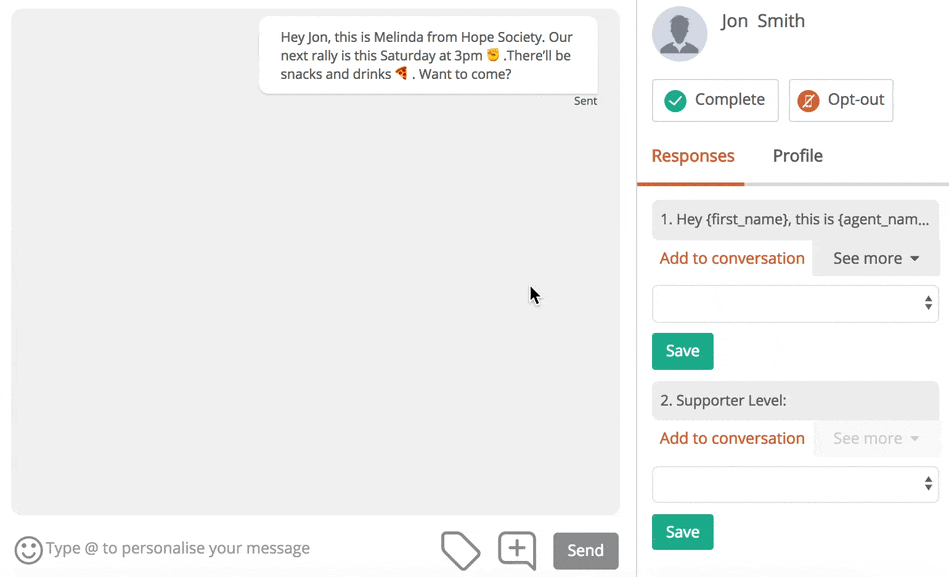
This example shows how an agent can update information on a prospect during P2P texting.
The P2P texting campaign need not be exclusively set up as a data-collection campaign. It can be done during other campaigns – say, an event invitation, with the information blended in amidst a conversation.
5. Phone calls for data collection

At the outset, using phone calls would seem rather counterintuitive—call center campaigns are notoriously resource-intensive.
However, like in the above SMS channel, information collection can happen as part of another objective.
For instance, if you reach out to a landline number in your campaign, you can quickly collect the lead’s phone number via that call.
During a voter ID campaign, you can ask the voter what are they causes they care about (e.g. healthcare, climate change, education etc.)
If you are calling for an event invitation, you can check if the person would be willing to volunteer or help out at later events.
Regardless of the purpose of your call, quality data can be collected via conversations.
For instance, during your call center campaign, saying, “ Can I please have your phone number?” may not be a good idea to get their phone number.
Instead you can say: “I can send you a short summary of what we discussed via a quick text. Can I have your number?” can get you better responses.
This chapter on persuasive cold calling has handy conversation tips for phone calls and other channels.
Let us now see how you can use these channels in setting up your list segmentation strategy.
How to do list segmentation
In many organizations, fundamental list segmentation is already in place. A nonprofit will definitely segment a major and a small donor separately for communication.
Advocacy organizations automatically reach out to their strongest supporters with volunteering asks.
Similarly, a business will reach a hot and a cold lead completely differently. The problem, however, is that this strategy is not always well structured.
If that is you, this breakdown will help you understand how to get more from your existing campaigns.
If you are setting up a list segmentation strategy from scratch, you will make solid progress in the right direction.
1. What is the problem you want solved?
In other words, define the end goal. What do you want to achieve by classifying your audience?
Classifying the audience into separate groups is not the end goal. It will give you insights that you can ultimately use to improve your goal.
For BBC it was increasing viewership, for Amazon, it was (and probably still is), increasing sales. For your organization, it could be any one of the below that will help you grow.
Increase or improve fundraising:
Despite having a list of prospects (major donors and small donors), a lot of nonprofits find it difficult to get them to donate again.
If this is your goal, list segmentation can help you identify repeat donors and highly engaged donors who can make the ask.
You can also see which channels a donor prefers and use that to reach out to him.
Getting higher event attendance:
If you repeatedly encounter a low turnout rate for events, it could mean that you are targeting the wrong segment of the audience.
See which age demographic resonates most with your cause (e.g., if it is climate change, many of your audience would be millennials).
Also, look at their past engagement details to see if they would be interested in turning up.
Recruiting more volunteers:
For a lot of organizations, a key metric of growth would be calculating an increase in supporters/volunteers.
If you are struggling with that, you may want to target your audience based on their demographics, lifestyles, and incomes.
That is, millennials are more likely to volunteer for a cause they believe in – for while they have more time, they may not have the money to make a donation.
2. What is the data you need to collect?
Honestly, not all organizations know what data to collect right from the start. They typically go with “as much as possible.”
However, it would be wise to classify the basic data you need (like the ones in the ‘classical list segmentation strategy’) to get started.
You can always continue to add to the database with whatever information you receive during your interaction with that lead.
3. What channels to use?
The next step is finalizing what lead generation channels to use and how to use them for list segmentation. This is typically informed by your goal and the kind of data you want to collect.
It is also dependent upon your audience’s behavior.
E.g. If you have a large social media followers, using Fb chat-bots make sense!
4. How to use/integrate the data?
After all the effort you have put into collecting the data, remember that it will be useful only if you integrate it with your outreach efforts.
That means you must carefully consider how you will collect data via different channels in one place.
It also means deciding how to integrate your database with your outreach channels – to ensure granular targeting.
Barriers you may face
Getting started with a fundamental list segmentation strategy is not tough. However, it can get quite complicated, as some of the steps are not straightforward.
Here are some hurdles to watch out for:
1. Difficulty in segmenting existing contacts
This is usually a side-effect of poor data collection in the past. According to a study, 92% of organizations believe that their data quality is insufficient to effectively support business objectives.
The complication can be twofold:
- Bad data: Most of the data you have could be plain wrong! E.g. the number 898084 does not belong to Jane Doe!
- Less data: If you do happen to find Jane Doe in that number, you realize that you know little else about her. What is her age demographic? What has her past behavior with you been? You have no answer to these questions, and worse, it severely affects your outreach!
Solution:
Use follow-up channels like texting and emails to collect more data about each lead. Information collection can make every outreach strategy you run more efficient.
2. Unwillingness of leads to give out information
Don’t worry—many organizations struggle with it, too. Thanks to the number of marketing campaigns, every lead is quite wary of handing out their information.
Solution:
Include conversational marketing in your lead generation program. Break down long forms into shorter ones. Follow up with your leads via texts and calls and get more information.
3. Integrating data collected into one system
Information collected during the rally via forms never reaches your database. Or, you have audience behavior across channels in separate places that do not flow into one system!
For instance, the open and response rates for your texting campaigns don’t flow into your CRM. This means you do not have a comprehensive view of your audience’s engagement behavior, and your outreach efforts would be much poorer for it.
Solution:
Democrats Abroad faced a similar problem (of data quality) during the 2018 US midterms. Their volunteers did not have enough accurate information on the voters they were having a conversation with. As a result, the quality of conversations suffered.
To address that, Dems Abroad integrated their Call Center software (CallHub) with NationBuilder so that the voter info from NationBuilder can be accessed while making calls.
Since the integration was two-way, any notes the volunteers made also flowed back to their database.
The takeaway here is to use tools that seamlessly integrate with each other so that data is shared across all platforms.
Before using a particular tool for lead generation, see how well it integrates with your existing database (open APIs) to facilitate data flow.
4. Data access across teams
How does Dave in Marketing know if a lead has already been converted? How does volunteer Mina know if a prospect has already contributed to the cause?
This information is crucial to planning outreach strategies. Otherwise, you will waste resources contacting the same lead with useless messages. Not only will this annoy your leads, but it will also be highly ineffective.
Solution:
Having a central database of all information is the first step. Arm your volunteers/agents with pertinent information right on their mobile or desktop.
Let us go back to the same Democrats Abroad case study. They used CallHub’s tags, custom fields, and surveys to ensure that the data collected could be used for list segmentation.
Here is a quick snapshot of how they used the system:
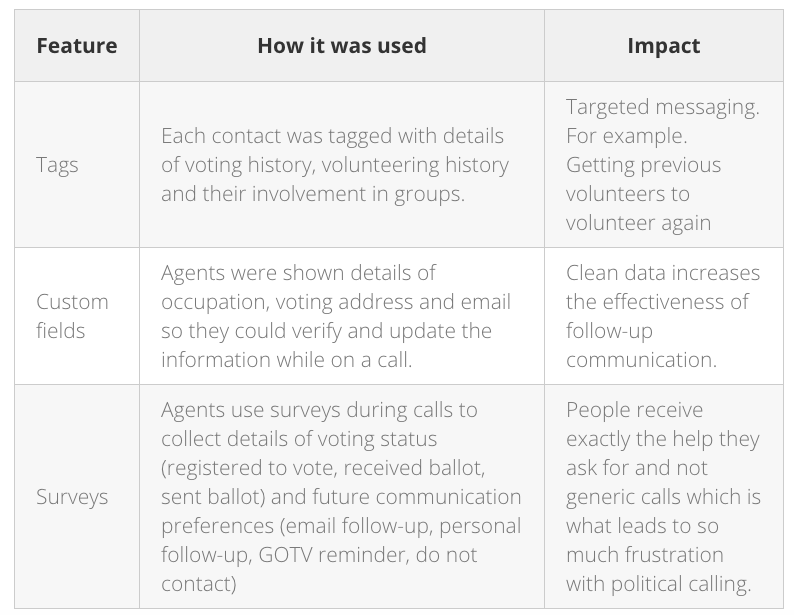
To replicate the same for your organization, check your APIs and integration between every team’s database while planning campaigns.
Takeaway
The idea of segmenting is to ensure that you have more meaningful conversations with your leads.
That means, after all this data collection (and list segmentation), you can still struggle with conversions if you are not using it right.
In the next chapter, we will see how SMS can be used for conversations.
